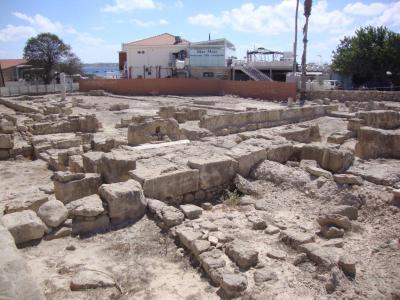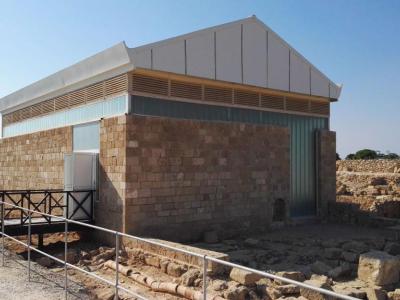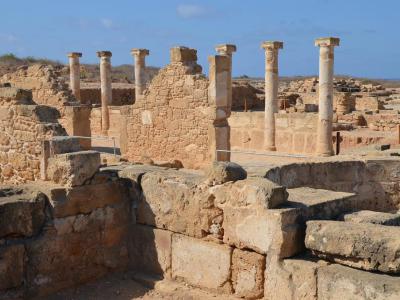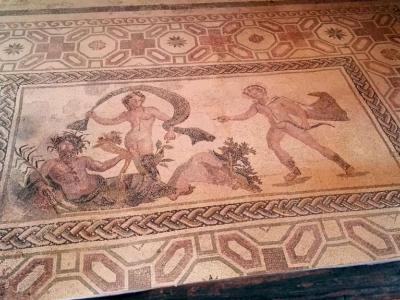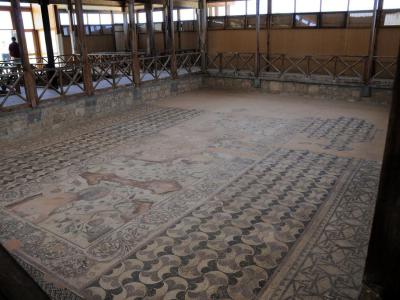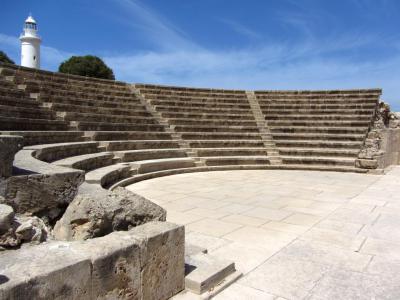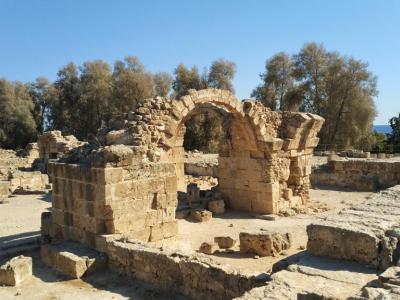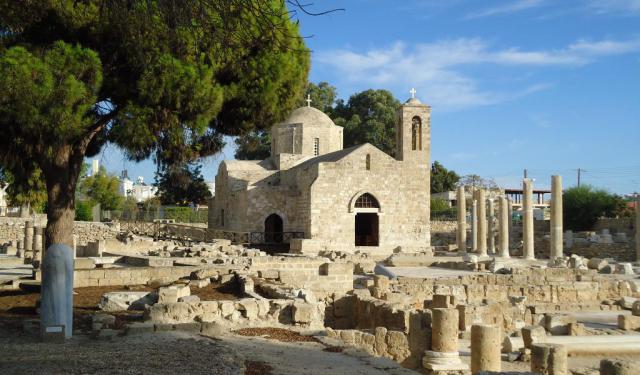Paphos Archaeological Park Walking Tour (Self Guided), Paphos
Paphos is divided into two parts. Kato Paphos, the area near the harbor, is where all the archaeological sites are located, while Ktima (Old Town) is where you'll find the museums. The Archaeological Park of Kato Paphos has been included in the UNESCO World Heritage Sites list since 1980.
This park includes sites and monuments from the 4th century BC to the Middle Ages, while most remains date to the Roman period.
The Basilica of Panagia Limeniotissa's ruin is one of the standout attractions within the park. Once a grand Christian basilica, it serves as a testament to the island's religious heritage, with remnants of beautiful mosaics transporting you back to a time of devotion and artistry.
Speaking of mosaics, the intricate floors of four Roman villas here (namely: the houses of Dionysos, Theseus, Aion, and Orpheus), depicting scenes from Greek mythology, form the impressive epicenter of the finds. These houses like time capsules provide insights into the daily lives and beliefs of the people who lived here centuries ago.
The Roman Odeon, an ancient amphitheater, is another highlight within the complex. Imagine sitting in its stone seats, transported back to a time when plays and concerts entertained the residents of Paphos.
As you wander further, you'll encounter the Forty Columns Castle (Saranta Kolones). This ancient fortification attests to the strategic importance of Paphos in antiquity.
Paphos Archaeological Park offers a blend of history, culture, and natural beauty. So, pack your bags, put on your walking shoes, and grab the opportunity to explore this archaeological wonder with the help of our self-guided tour. It's an experience you won't soon forget!
This park includes sites and monuments from the 4th century BC to the Middle Ages, while most remains date to the Roman period.
The Basilica of Panagia Limeniotissa's ruin is one of the standout attractions within the park. Once a grand Christian basilica, it serves as a testament to the island's religious heritage, with remnants of beautiful mosaics transporting you back to a time of devotion and artistry.
Speaking of mosaics, the intricate floors of four Roman villas here (namely: the houses of Dionysos, Theseus, Aion, and Orpheus), depicting scenes from Greek mythology, form the impressive epicenter of the finds. These houses like time capsules provide insights into the daily lives and beliefs of the people who lived here centuries ago.
The Roman Odeon, an ancient amphitheater, is another highlight within the complex. Imagine sitting in its stone seats, transported back to a time when plays and concerts entertained the residents of Paphos.
As you wander further, you'll encounter the Forty Columns Castle (Saranta Kolones). This ancient fortification attests to the strategic importance of Paphos in antiquity.
Paphos Archaeological Park offers a blend of history, culture, and natural beauty. So, pack your bags, put on your walking shoes, and grab the opportunity to explore this archaeological wonder with the help of our self-guided tour. It's an experience you won't soon forget!
How it works: Download the app "GPSmyCity: Walks in 1K+ Cities" from Apple App Store or Google Play Store to your mobile phone or tablet. The app turns your mobile device into a personal tour guide and its built-in GPS navigation functions guide you from one tour stop to next. The app works offline, so no data plan is needed when traveling abroad.
Paphos Archaeological Park Walking Tour Map
Guide Name: Paphos Archaeological Park Walking Tour
Guide Location: Cyprus » Paphos (See other walking tours in Paphos)
Guide Type: Self-guided Walking Tour (Sightseeing)
# of Attractions: 7
Tour Duration: 1 Hour(s)
Travel Distance: 2.0 Km or 1.2 Miles
Author: DanaOffice
Sight(s) Featured in This Guide:
Guide Location: Cyprus » Paphos (See other walking tours in Paphos)
Guide Type: Self-guided Walking Tour (Sightseeing)
# of Attractions: 7
Tour Duration: 1 Hour(s)
Travel Distance: 2.0 Km or 1.2 Miles
Author: DanaOffice
Sight(s) Featured in This Guide:
- Basilica of Panagia Limeniotissa
- House of Aion
- House of Theseus
- House of Orpheus
- The House of Dionysus
- Roman Odeon
- Saranta Kolones (Forty Columns Castle)
1) Basilica of Panagia Limeniotissa
The Basilica of Panagia Limeniotissa, founded at the dawn of the 5th century, is a remarkable testimony to faith and architectural grandeur. Dedicated to "Our Lady of the Harbour," Panagia Limeniotissa remains a captivating archaeological site within the Paphos Archaeological Park, offering visitors a glimpse into the past.
Panagia Limeniotissa was originally constructed during the early Christian period when Cyprus was an integral part of the Byzantine Empire. The basilica's grand design included three impressive aisles with twin rows of majestic marble columns, a resplendent apse, and an inviting narthex. Throughout its sacred halls, the walls and floors were adorned with colorful mosaics, resplendent in intricate geometric patterns.
Over the centuries, Panagia Limeniotissa witnessed both triumph and tragedy. In 653 AD, the basilica suffered near destruction during the Arab raids that swept across the island. The Arab conquerors repurposed the site for their garrison, converting it into workshops, stables, and living quarters for their military. They even erected a tower in the narthex, a structure that served various functions, including a watchtower, a lighthouse, or a minaret.
After the Arab retreat from the island in 688 AD, the basilica was restored. Although reduced in scale compared to its grandeur, it maintained its role as a three-aisled barrel-vaulted basilica, standing as a symbol of resilience and renewal.
In 1159 AD, a devastating earthquake, recounted by Saint Neophytos, led to the church's destruction along with thirteen others in the Paphos district. As the years passed, the basilica was abandoned, and its exact location was lost amidst the ruins of Nea Paphos. It was only in the 20th century that the Basilica of Panagia Limeniotissa resurfaced. Its rediscovery began in 1937 and was formally excavated in 1959.
Today, the basilica proudly stands as part of the Paphos Archaeological Park, a UNESCO World Heritage Site.
Panagia Limeniotissa was originally constructed during the early Christian period when Cyprus was an integral part of the Byzantine Empire. The basilica's grand design included three impressive aisles with twin rows of majestic marble columns, a resplendent apse, and an inviting narthex. Throughout its sacred halls, the walls and floors were adorned with colorful mosaics, resplendent in intricate geometric patterns.
Over the centuries, Panagia Limeniotissa witnessed both triumph and tragedy. In 653 AD, the basilica suffered near destruction during the Arab raids that swept across the island. The Arab conquerors repurposed the site for their garrison, converting it into workshops, stables, and living quarters for their military. They even erected a tower in the narthex, a structure that served various functions, including a watchtower, a lighthouse, or a minaret.
After the Arab retreat from the island in 688 AD, the basilica was restored. Although reduced in scale compared to its grandeur, it maintained its role as a three-aisled barrel-vaulted basilica, standing as a symbol of resilience and renewal.
In 1159 AD, a devastating earthquake, recounted by Saint Neophytos, led to the church's destruction along with thirteen others in the Paphos district. As the years passed, the basilica was abandoned, and its exact location was lost amidst the ruins of Nea Paphos. It was only in the 20th century that the Basilica of Panagia Limeniotissa resurfaced. Its rediscovery began in 1937 and was formally excavated in 1959.
Today, the basilica proudly stands as part of the Paphos Archaeological Park, a UNESCO World Heritage Site.
2) House of Aion
The House of Aion, a magnificent villa nestled in the heart of Paphos, offers a captivating portal to the opulent world of ancient Roman art. Although only three rooms have been excavated by the University of Warsaw, the villa's mosaic floor stands as a masterpiece of unrivaled significance, stirring scholarly discussions and captivating imaginations.
Dating back to the mid-4th century AD, the House of Aion derives its name from the central figure in its remarkable mosaic - Aion, the god of eternal time. This mosaic is a masterpiece like no other, showcasing exceptional artistry that remains both enigmatic and fervently discussed by experts.
The main room within this grand villa was likely a triclinium or a reception area, designed to impress visitors with its grandeur. Two smaller rooms, meanwhile, feature geometric mosaics that astound with their precision and detail.
The centerpiece of the House of Aion is the main mosaic, a work of art that immediately draws the eye and captivates the soul. This astonishing mosaic unfolds in three horizontal frames, each housing five panels of intricate and expressive art. Surrounding this masterpiece is a geometric frame, adding to the overall appeal.
Interestingly, during excavations, archaeologists stumbled upon a villa wall that had collapsed into the adjacent street. Through dedicated restoration efforts, this architectural gem has been revived, offering a glimpse into the villa's structure and the Roman era's architectural prowess.
Dating back to the mid-4th century AD, the House of Aion derives its name from the central figure in its remarkable mosaic - Aion, the god of eternal time. This mosaic is a masterpiece like no other, showcasing exceptional artistry that remains both enigmatic and fervently discussed by experts.
The main room within this grand villa was likely a triclinium or a reception area, designed to impress visitors with its grandeur. Two smaller rooms, meanwhile, feature geometric mosaics that astound with their precision and detail.
The centerpiece of the House of Aion is the main mosaic, a work of art that immediately draws the eye and captivates the soul. This astonishing mosaic unfolds in three horizontal frames, each housing five panels of intricate and expressive art. Surrounding this masterpiece is a geometric frame, adding to the overall appeal.
Interestingly, during excavations, archaeologists stumbled upon a villa wall that had collapsed into the adjacent street. Through dedicated restoration efforts, this architectural gem has been revived, offering a glimpse into the villa's structure and the Roman era's architectural prowess.
3) House of Theseus
The House of Theseus, a grand residence nestled in the heart of Paphos, is not merely a testament to the opulence of the Roman era but a fascinating link to the past. This exceptionally large villa, once the residence of the Roman proconsul or governor, provides a unique perspective into the architectural splendor of ancient times.
The villa's name originates from one of its most breathtaking features, a mosaic that narrates the tale of Theseus and the Minotaur. This artwork, found in the southeast quarter of the villa, is a testament to the incredible craftsmanship and attention to detail exhibited by ancient Roman artisans.
This villa, a remarkable structure, was divided to serve various purposes, with rooms designated for official functions and others for private use. It covered several insulae, or blocks, according to the Hellenistic street plan, highlighting its vastness and significance.
Built during the latter half of the 2nd century AD, this architectural gem was constructed atop the ruins of earlier houses, connecting the Roman era with its predecessors. The villa continued to serve its purpose until the 7th century AD when it witnessed a significant historical transformation.
While the House of Theseus carries an air of mystery and awe, it's essential to note that only the southern half of the villa has been fully excavated. However, the segments explored and preserved provide a tantalizing glimpse into the daily lives, administrative functions, and artistic sophistication of the Romans who once dwelled within these walls.
The villa's name originates from one of its most breathtaking features, a mosaic that narrates the tale of Theseus and the Minotaur. This artwork, found in the southeast quarter of the villa, is a testament to the incredible craftsmanship and attention to detail exhibited by ancient Roman artisans.
This villa, a remarkable structure, was divided to serve various purposes, with rooms designated for official functions and others for private use. It covered several insulae, or blocks, according to the Hellenistic street plan, highlighting its vastness and significance.
Built during the latter half of the 2nd century AD, this architectural gem was constructed atop the ruins of earlier houses, connecting the Roman era with its predecessors. The villa continued to serve its purpose until the 7th century AD when it witnessed a significant historical transformation.
While the House of Theseus carries an air of mystery and awe, it's essential to note that only the southern half of the villa has been fully excavated. However, the segments explored and preserved provide a tantalizing glimpse into the daily lives, administrative functions, and artistic sophistication of the Romans who once dwelled within these walls.
4) House of Orpheus
The House of Orpheus serves as an exquisite testament to the artistry and architectural sophistication of the Roman era. This remarkable structure derives its name from the breathtaking mosaics it harbors, where the legendary figure of Orpheus enchants wild animals with his melodious lyre.
As you step into the House of Orpheus, you are transported back in time to an era of Roman opulence. This house, with its expansive rooms and courtyards, offers a vivid portrayal of the luxurious Roman domestic life.
The centerpiece of the House of Orpheus is the mosaic depicting the legendary musician Orpheus charming a mesmerized audience of wild animals with his lyre. This intricate mosaic is a masterpiece of Roman art, capturing both the artistic prowess of its creator and the enchanting narrative of Orpheus.
Throughout the house, one can find depictions of various mythical themes, including formidable Amazon warriors and scenes from the heroic tales of ancient Greece and Rome. Each mosaic serves as a window into the rich tapestry of Roman mythology and daily life.
As you step into the House of Orpheus, you are transported back in time to an era of Roman opulence. This house, with its expansive rooms and courtyards, offers a vivid portrayal of the luxurious Roman domestic life.
The centerpiece of the House of Orpheus is the mosaic depicting the legendary musician Orpheus charming a mesmerized audience of wild animals with his lyre. This intricate mosaic is a masterpiece of Roman art, capturing both the artistic prowess of its creator and the enchanting narrative of Orpheus.
Throughout the house, one can find depictions of various mythical themes, including formidable Amazon warriors and scenes from the heroic tales of ancient Greece and Rome. Each mosaic serves as a window into the rich tapestry of Roman mythology and daily life.
5) The House of Dionysus (must see)
The House of Dionysos, a prominent feature of the Paphos Archaeological Park in Cyprus, is one of four Roman villas renowned for their exquisite floor mosaics. These Roman villas are collectively known as the Mosaic Houses, each adorned with intricately crafted mosaics that provide a fascinating glimpse into the art and culture of the period.
The House of Dionysos is celebrated for its remarkable floor mosaics that grace its interior. These mosaics, meticulously composed of limestone tiles, are believed to have been created during the second and third centuries AD. Intriguingly, these intricate artworks remained hidden from view until 1962 when a local farmer stumbled upon them.
This extraordinary villa, which occupies a total area of 2000 square meters, is named after the Greek god Dionysos. The god Dionysos is a recurring theme in many of the mosaics found within the villa. These mosaics depict scenes from mythology, history, and hunting, and they offer valuable insights into the cultural and artistic influences of the time.
The House of Dionysos features a well-planned architectural layout. Its rooms are organized around a central courtyard, known as an atrium, which served as the heart of the villa. This central space was not only aesthetically pleasing but also functioned as a hub for various activities within the house.
The villa's construction dates back to the end of the 2nd century AD, representing a significant period of Roman rule in Cyprus. However, the villa's decline and eventual abandonment were prompted by a series of devastating earthquakes in the 4th century AD. These natural disasters led to the villa's structural damage and its eventual abandonment.
Beneath the House of Dionysos, evidence of an earlier villa from the 3rd century BC has been discovered. This villa is particularly notable for its Hellenistic pebble mosaic that portrays the mythical sea-monster Scylla. This ancient mosaic has been preserved in its original location, offering a unique opportunity to observe the historical and artistic transition between different periods.
The House of Dionysos, along with the other Mosaic Houses in the area, stands as a testament to the opulence and cultural sophistication of the Roman era in Paphos. The well-preserved mosaics are a vivid representation of the artistic achievements and interests of the time, allowing modern visitors to step back in history and appreciate the enduring beauty of these ancient works of art.
The House of Dionysos is celebrated for its remarkable floor mosaics that grace its interior. These mosaics, meticulously composed of limestone tiles, are believed to have been created during the second and third centuries AD. Intriguingly, these intricate artworks remained hidden from view until 1962 when a local farmer stumbled upon them.
This extraordinary villa, which occupies a total area of 2000 square meters, is named after the Greek god Dionysos. The god Dionysos is a recurring theme in many of the mosaics found within the villa. These mosaics depict scenes from mythology, history, and hunting, and they offer valuable insights into the cultural and artistic influences of the time.
The House of Dionysos features a well-planned architectural layout. Its rooms are organized around a central courtyard, known as an atrium, which served as the heart of the villa. This central space was not only aesthetically pleasing but also functioned as a hub for various activities within the house.
The villa's construction dates back to the end of the 2nd century AD, representing a significant period of Roman rule in Cyprus. However, the villa's decline and eventual abandonment were prompted by a series of devastating earthquakes in the 4th century AD. These natural disasters led to the villa's structural damage and its eventual abandonment.
Beneath the House of Dionysos, evidence of an earlier villa from the 3rd century BC has been discovered. This villa is particularly notable for its Hellenistic pebble mosaic that portrays the mythical sea-monster Scylla. This ancient mosaic has been preserved in its original location, offering a unique opportunity to observe the historical and artistic transition between different periods.
The House of Dionysos, along with the other Mosaic Houses in the area, stands as a testament to the opulence and cultural sophistication of the Roman era in Paphos. The well-preserved mosaics are a vivid representation of the artistic achievements and interests of the time, allowing modern visitors to step back in history and appreciate the enduring beauty of these ancient works of art.
6) Roman Odeon
Built in the 2nd century AD, the Roman Odeon is a remarkable structure that was hewn entirely from pristine limestone rocks, showcasing the craftsmanship and grandeur of its time.
One of the most revered historical sites in Cyprus, the Roman Odeon has not only witnessed centuries of history but has also played a pivotal role in the cultural and artistic life of the city. Surrounded by remnants of the past, the site paints a vivid picture of ancient Paphos.
To the south of the Odeon, one can explore the evocative remains of the Roman temple of Asclepius, the God of Medicine. It is a testament to the religious and spiritual beliefs of the people of that era, offering a glimpse into their reverence for the healing arts. On the northern side of the Odeon, visitors can encounter the remains of ancient town walls, which once defined the boundaries of this thriving settlement.
Adjacent to the Odeon, and in close proximity to the New Paphos Lighthouse, lies a rocky mound that is believed to have served as the Acropolis of the town. This ancient site provides a window into the city's strategic and defensive history.
The Department of Antiquities in Cyprus has undertaken partial restoration, including the preservation of 12 rows of seating, making it an ideal venue for live musical and theatrical performances. The Odeon, which once hosted the voices of ancient actors and poets, now echoes with contemporary melodies and stories, bridging the gap between the past and the present.
One of the most revered historical sites in Cyprus, the Roman Odeon has not only witnessed centuries of history but has also played a pivotal role in the cultural and artistic life of the city. Surrounded by remnants of the past, the site paints a vivid picture of ancient Paphos.
To the south of the Odeon, one can explore the evocative remains of the Roman temple of Asclepius, the God of Medicine. It is a testament to the religious and spiritual beliefs of the people of that era, offering a glimpse into their reverence for the healing arts. On the northern side of the Odeon, visitors can encounter the remains of ancient town walls, which once defined the boundaries of this thriving settlement.
Adjacent to the Odeon, and in close proximity to the New Paphos Lighthouse, lies a rocky mound that is believed to have served as the Acropolis of the town. This ancient site provides a window into the city's strategic and defensive history.
The Department of Antiquities in Cyprus has undertaken partial restoration, including the preservation of 12 rows of seating, making it an ideal venue for live musical and theatrical performances. The Odeon, which once hosted the voices of ancient actors and poets, now echoes with contemporary melodies and stories, bridging the gap between the past and the present.
7) Saranta Kolones (Forty Columns Castle)
In the heart of the Paphos Archaeological Park lies the intriguing Forty Columns Castle. This medieval fortress is steeped in history, and its evocative name is derived from the numerous granite columns discovered on the site, which are believed to have once graced the ancient agora.
The story of Forty Columns Castle begins in the late 7th century AD. It was during this time that the Byzantines constructed this formidable castle to serve a crucial role: to protect the bustling port and the city of Nea Pafos from the persistent threat of Arab raids. Standing tall, it was a symbol of defense and resilience in the face of adversity.
Over time, this Byzantine stronghold experienced a series of transformations. The Lusignans, known for their architectural prowess, undertook its remodeling, further enhancing its defensive capabilities and grandeur. Forty Columns Castle was an imposing sight with its three-meter-thick walls, crowned by four massive corner towers and an additional four intermediary towers positioned along the joining walls. A protective moat encircled the castle, and access was granted through a sturdy wooden bridge that spanned this watery barrier.
Stepping into Saranta Kolones reveals a square courtyard measuring 35 meters in both length and width. Here, a tower graced each corner, a symbol of strength and resilience. The main entrance, however, lay on the east side, guarded by a fifth horseshoe-shaped tower.
Despite its might and purpose, Saranta Kolones couldn't escape the fickle hand of fate. In 1222, an earthquake shook the foundations of the fortress, leading to its eventual downfall. The castle, once a symbol of protection, was subsequently abandoned.
In more recent times, archaeologists have embarked on a series of excavations, seeking to unlock the mysteries held within Saranta Kolones. These endeavors have shed light on the castle's past, revealing the architectural wonders and the stories of its defenders. Visitors today have the opportunity to explore the ruins and walk in the footsteps of those who safeguarded Paphos long ago.
The story of Forty Columns Castle begins in the late 7th century AD. It was during this time that the Byzantines constructed this formidable castle to serve a crucial role: to protect the bustling port and the city of Nea Pafos from the persistent threat of Arab raids. Standing tall, it was a symbol of defense and resilience in the face of adversity.
Over time, this Byzantine stronghold experienced a series of transformations. The Lusignans, known for their architectural prowess, undertook its remodeling, further enhancing its defensive capabilities and grandeur. Forty Columns Castle was an imposing sight with its three-meter-thick walls, crowned by four massive corner towers and an additional four intermediary towers positioned along the joining walls. A protective moat encircled the castle, and access was granted through a sturdy wooden bridge that spanned this watery barrier.
Stepping into Saranta Kolones reveals a square courtyard measuring 35 meters in both length and width. Here, a tower graced each corner, a symbol of strength and resilience. The main entrance, however, lay on the east side, guarded by a fifth horseshoe-shaped tower.
Despite its might and purpose, Saranta Kolones couldn't escape the fickle hand of fate. In 1222, an earthquake shook the foundations of the fortress, leading to its eventual downfall. The castle, once a symbol of protection, was subsequently abandoned.
In more recent times, archaeologists have embarked on a series of excavations, seeking to unlock the mysteries held within Saranta Kolones. These endeavors have shed light on the castle's past, revealing the architectural wonders and the stories of its defenders. Visitors today have the opportunity to explore the ruins and walk in the footsteps of those who safeguarded Paphos long ago.
Walking Tours in Paphos, Cyprus
Create Your Own Walk in Paphos
Creating your own self-guided walk in Paphos is easy and fun. Choose the city attractions that you want to see and a walk route map will be created just for you. You can even set your hotel as the start point of the walk.
Paphos Introduction Walking Tour
For most people, the mesmerizing town of Paphos on the southwestern coast of Cyprus is all about sun, sand, and sea. However, alongside its beachy vibes, this seaside resort is home to a swag of important historical tourist attractions that contributed to Paphos being anointed European Capital of Culture in 2017.
Indeed, as a UNESCO World Heritage-listed city, Paphos is steeped in both... view more
Tour Duration: 2 Hour(s)
Travel Distance: 4.1 Km or 2.5 Miles
Indeed, as a UNESCO World Heritage-listed city, Paphos is steeped in both... view more
Tour Duration: 2 Hour(s)
Travel Distance: 4.1 Km or 2.5 Miles
The Most Popular Cities
/ view all



